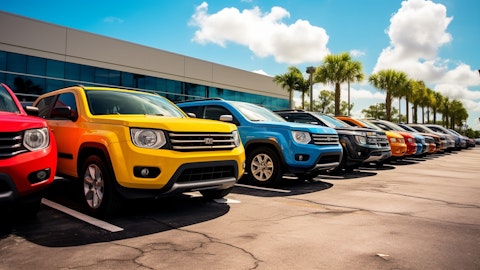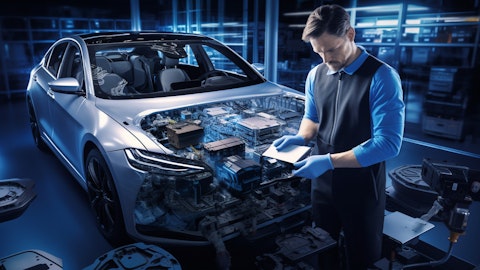But also making sure that the core business gets what it needs as things become more available. And as you know, last few years have been very tight vehicle supply, courtesy cars were under pressure under pressure is that’s easing a bit now. We are now able to get that service to our customers. And then the other area that we invest in is obviously on our people and we are seeing not just inflationary increases in terms of people, but also some of the other things that we’re doing to try and make sure that we reduce turnover and improve engagement in our teams. So it is a balance but within that range that Tom talked about. Hopefully that color that helps as well.
Douglas Dutton : No, excellent. That’s great detail. I appreciate this detailed answer here. Just a quick one on CFS too. You said there’s good attach rates there. About $160 million in new loans this quarter and the portfolio is now at about $560 million. Do you expect a similar cadence going forward on originations and penetration or how should we think about that growth as we progress through the rest of the rest of the year and into next year?
Michael Manley : Yeah, great question, Doug, I don’t think you can expect the portfolio to double every year. I mean, we are dealing with reason is a captive market for us, in that we’re dealing with the $300 million or sorry 300 or so AutoNation stores. The name of the game is to get as much penetration as we can on the financing business, but there is a limit for that. I do think the earlier years of AN Finance you’ll see very, very outsized growth rates. But I think the portfolio doubling this year. That just mathematically can’t happen every year, but it will give us good growth and as I said earlier, I do expect once we get to a normalized portfolio size and we begin to do some securitizations, I think you’ll see some nice accretion from an earnings perspective into the calculus we get to that point to be able to position. So, and we are all entirely supported by our operating teams and it’s really is improving the relationship we have with our customers.
Thomas Szlosek : It’s got massive. I mean that business got massive SG&A leverage. I mean, all the [Indiscernible] there, so it is about now really, really increasing the throughput in a very deliberate and thoughtful way.
Douglas Dutton : Okay. Thank you. Makes sense. Thanks, Tom. Thanks, Mike.
Operator: Our next question comes from Colin Langan from Wells Fargo.
Colin Langan : Oh great. Thanks for taking my questions. Can you just remind us your latest thinking on where new gross profits go? I mean, I think the comments in the past were that you sort of it get back to on a percent basis historic levels. Is that still the thinking in any concern that maybe we kind of overcorrect this thing continue to normalize?
Michael Manley : Yeah, Colin, thanks for the question. I’m going to answer this. So, as I think about new vehicle margins as I said there’s a number that haven’t touched – very briefly touched on your right in terms of our percentage margin. What you’ve seen since, let’s take 2019 as the pre-pandemic year, what you’ve seen since then and now is obviously significant increase in ASPs. And I don’t – even though I see ASPs moderating, as we go forward, as mix comes back in to a more normalized level as OEMs continue to gradually increase their incentives to stimulate demand. I don’t see ASPs returning back to the 2019 level, which inherently if you’re able to hold those in percentage margin means from a dollar perspective on a per unit basis, we should and probably expect high dollar margins than we saw pre-pandemic even if we return to that percentage margin that you mentioned at the beginning.
Obviously, as we transition as an industry into higher levels of electrified vehicles, we know from the impact that we saw in 2023 and still see in terms of TIN margin and TIN margin for me is purely what’s attributable to the vehicle excluding everything out. TIN margin came under pressure particularly in fully electrified vehicles as OEM dealers, all of us were trying to stimulate takeaways. That to some extent as I’ve mentioned, the balance at the beginning of my opening comments I think is why we’re we are being in favorably about that. But that is a dynamic that will until they drive – until OEMs are able to drive the cost low in those vehicles be an impact on our business. But what has changed is if you look at the lease rates of electrified vehicles, that’s doubled in the last 12 months and losing electrified vehicles in my view more balances the contribution to the ASP in the marketplace that the customers are happy or more prepared to accept.
So, quite a lot in my answer, apologies for that, but that’s none of my thinking on new vehicles in total.
Colin Langan : And any – given the – we’ve seen you kind of indicated I think 69 days of domestic supply, how is the profitability – have certain brands already kind of returned to normalized level of profits and is that consistent with the thinking that on a percent basis they’re kind of similar to pre-COVID levels or those kind of getting closer to being fully back?
Michael Manley : I mean, it’s very smooth at this moment in time and for each – so if you look at our portfolio at 31 brands across our portfolio, so we get quite a very broad view of what’s going on in the marketplace. And there are certain manufacturers whose days of supply, they’re not back to where they were in say 2018, 2019 from a days of that supply was faced with, but neither is the overall new vehicle market. So obviously, we have seen different dynamics in terms of margin by OEM. Still some of that driven purely by the supply and demand curve. But as OEMs have been able to fill up their pipeline and we’ve got more mix on the ground, you’ve also seen an incremental increase in terms of their incentive – in terms of the use of the leasing, rather than pure finance and as such, we do see an impact on our margin, which you see in our P&L.
But from my point of view, our net result and what I’ve said suggests that even with those supply that will continue to increase from a dollar perspective per unit even though it’s going to moderate for sure during the balance of this year. And I don’t see anyone quite yet back towards exactly where they were ‘18 ‘19.
Colin Langan : Got it. Alright. Thanks for taking the question.
Operator: And that was our final questions. I will now hand you back over to Mike Manley.
Michael Manley : Yeah, thank you, everybody. And again thank you very much for taking the time to be on the call with us today. As we mentioned, I think AutoNation once again delivered solid operating results in the quarter and our efforts resulted also in strong cash conversion, which as we’ve discussed on this call provided us with the flexibility to deploy capital for attractive returns. Obviously, we’re going to continue to invest in the growth of our business as we look to optimize our operations, build on the fantastic footprint of portfolio of stores that we’ve had. And in closing, I would say, that although I’m certain 2024 will continue to bring its normal mix of headwinds and tailwinds, I think the AutoNation team understands what we would like to deliver very focused on delivering that and ultimately that will result in what I am determined to deliver and that’s great shareholder returns. Thank you.
Operator: And this concludes today’s call. Thank you for joining. You may now disconnect your lines.
Follow Autonation Inc. (NYSE:AN)
Follow Autonation Inc. (NYSE:AN)
Receive real-time insider trading and news alerts





